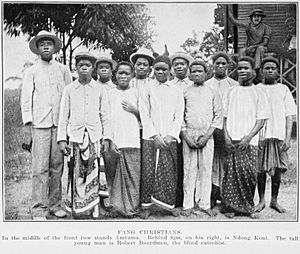Beti-Pahuin peoples facts for kids
The Beti-Pahuin are a large group of people who live in the rainforests of Central Africa. You can find them in countries like Cameroon, the Republic of the Congo, Equatorial Guinea, Gabon, and São Tomé and Príncipe. Even though they have many different smaller groups (called clans), they all share a similar background, history, and way of life.
There are over 8 million Beti-Pahuin people today. They are the biggest ethnic group in central Cameroon, including its capital city, Yaoundé. They are also the largest group in Gabon and Equatorial Guinea. They speak different versions of the Beti language, but they can usually understand each other.
Contents
Who are the Beti-Pahuin?
The Beti-Pahuin group includes more than 20 smaller groups, or clans. They live in a large area of forests and rolling hills. This area stretches from the Sanaga River in the north to Equatorial Guinea and parts of Gabon and Congo in the south. It also goes from the Atlantic Ocean in the west to the Dja River in the east.
The Beti Groups
The first main group is called the Beti. This includes groups like the Ewondo, Bane, Fang (M'fang), Mbida-Mbane, Mvog-Nyenge, Bran, and Eton.
The Ewondo people are mostly found around Yaoundé, which is the capital of Cameroon and was named after them. Their language, also called Ewondo, is spoken by many people in Cameroon. It helps people from different groups communicate in Yaoundé and other parts of the country.
The Eton people mainly live in the Lekie area of Cameroon. They speak the Eton language, and about 500,000 people spoke it in 1982.
The Fang Groups
The Fang (or Fan) make up the second big group. This includes the Fang people themselves, plus the Ntumu, Mvae, and Okak. Fang lands start in southern Cameroon and go south into Equatorial Guinea, Gabon, and the Congo.
The Bulu Groups
The third main group is called the Bulu. They make up about one-third of all Beti-Pahuin people in Cameroon. The Bulu include groups like the Bulu proper (from Sangmélima, Kribi, and Ebolowa), the Fong, Zaman, Yengono, Yembama, Yelinda, Yesum, Yebekanga, Yebekolo, and Mvele.
Other Groups
Some other groups are also becoming part of the Beti-Pahuin community. These include the Manguissa, Yekaba, Bamvele, Evuzok, Batchanga, Omvang, Yetude, and even some of the Baka people.
Life and Culture
Many Beti-Pahuin people work in farming, especially growing cocoa and coffee.
The Beti-Pahuin people traditionally organize themselves through family lines, mostly following the father's side. However, some groups used to follow the mother's side in the past. Because of this, the connection between a maternal uncle and his nephew is still very strong today. The basic unit of their society is the family, which includes a man, his wife or wives, and their children. Several families from the same lineage live together in a village. Several related villages then form a clan. These clans are usually led by a chief, who is also seen as a religious leader.
Most Beti-Pahuin groups live in small villages along roads. These villages usually have houses lined up along the road, with the forest behind them. Traditional homes are made from dried-mud bricks on a bamboo frame, with roofs made of raffia-palm leaves. Nowadays, metal roofs are common, and wealthier people might build homes with concrete.
There are also larger towns and cities in Beti-Pahuin territory. Many of these were started by the Germans or French. In these places, the towns are more like European cities, with streets, different neighborhoods, and central areas for businesses and government.
What They Eat
Most Beti-Pahuin people live by farming. Their main foods are Manioc and maize (corn). Plantains, yams, and groundnuts (peanuts) are also very important. In fact, "Ewondo" and "Yaoundé" can mean "groundnut." They also gather many things from the forest, like greens, insects, mushrooms, and palm products, to add to their diet.
They usually keep small animals like goats, pigs, and chickens, which often roam freely. These animals are usually saved for special events like funerals or New Year's Day. For everyday protein, they often eat bushmeat, which is wild game like pangolins, porcupines, and monkeys caught by hunters in the jungle. Fishing is also very important for many Beti-Pahuin, especially those in Equatorial Guinea and São Tomé and Príncipe.
Many Beti-Pahuin also work on cocoa farms in Equatorial Guinea, Gabon, and southern Cameroon. Most of these workers are Bulus or Fangs, as their areas have the most farms. The Ewondos, who live in more urban areas, often work in other jobs that don't require special skills. In the past, many Beti-Pahuin were very skilled at working with wood, ivory, and soapstone. They were especially known for their lively masks.
Beliefs and Religion
Most Beti-Pahuin people became Christians by 1939. At that time, many of their old traditions, including some native dances and songs, were put aside. After the colonial period ended, their traditional religions, like the Bwiti religion, became popular again. New styles of music and dance, such as the Bikutsi music of the Ewondos, also became popular.
Today, many Beti-Pahuin people consider themselves Christian and go to church on Sundays. However, they might also attend various secret societies or visit a traditional healer at other times during the week.
Other Languages Spoken
Some Fang people also speak or understand the official languages of their countries:
- Spanish in Equatorial Guinea
- French in Cameroon, Equatorial Guinea, and Gabon
- Portuguese, Angolar, Principense, and Forro in São Tomé and Príncipe
- English in Cameroon
See also
 In Spanish: Pueblo beti-pahuin para niños
In Spanish: Pueblo beti-pahuin para niños



